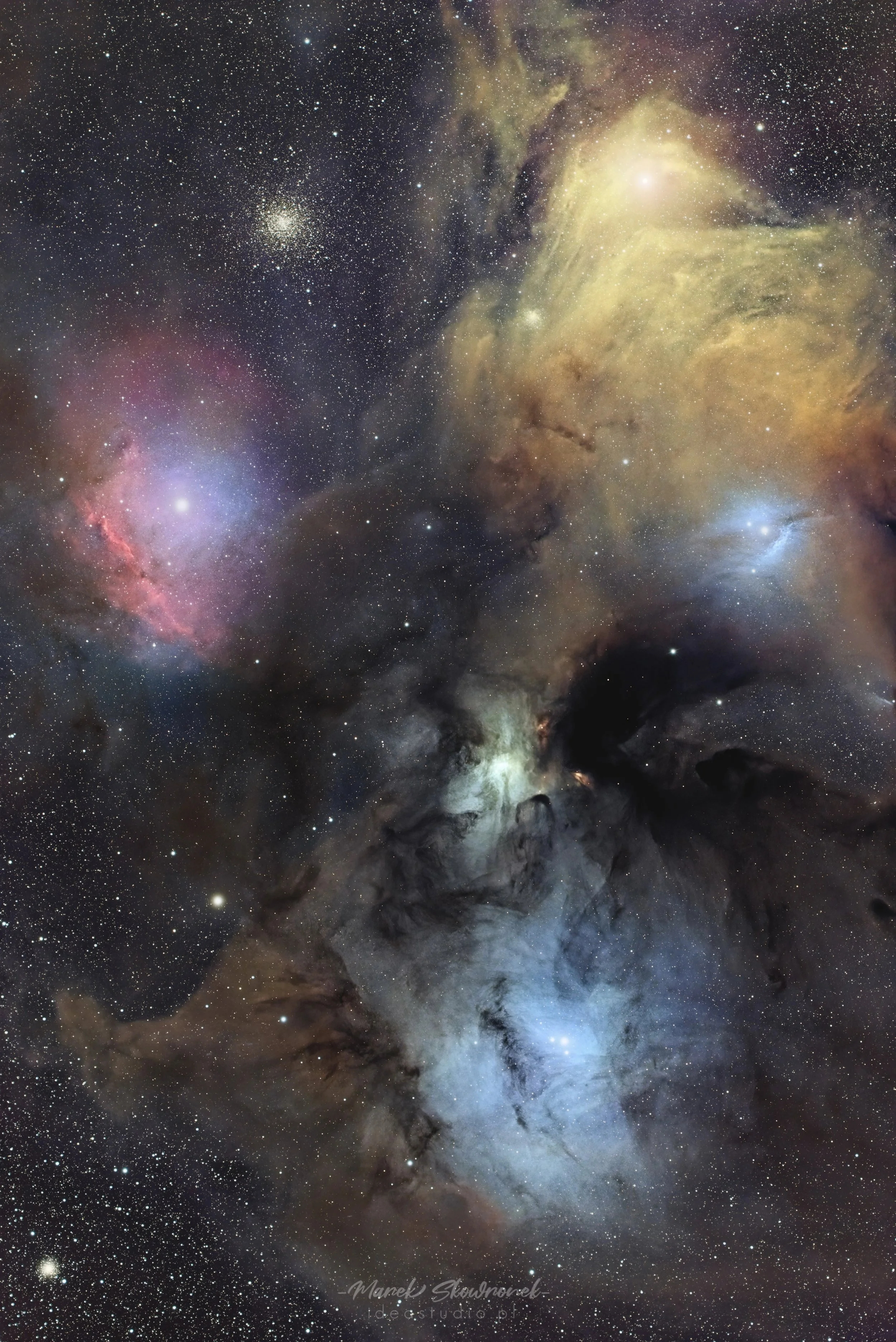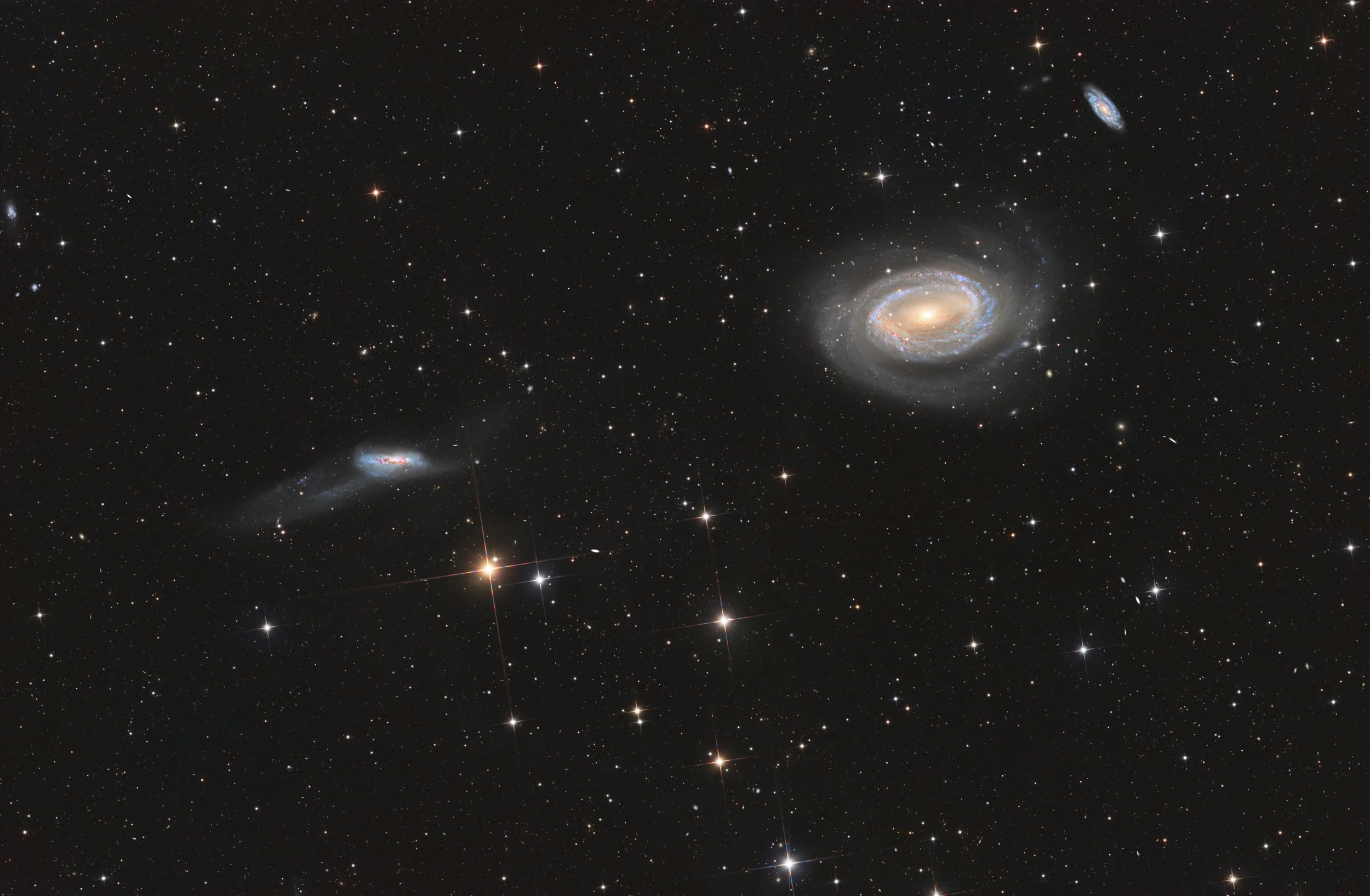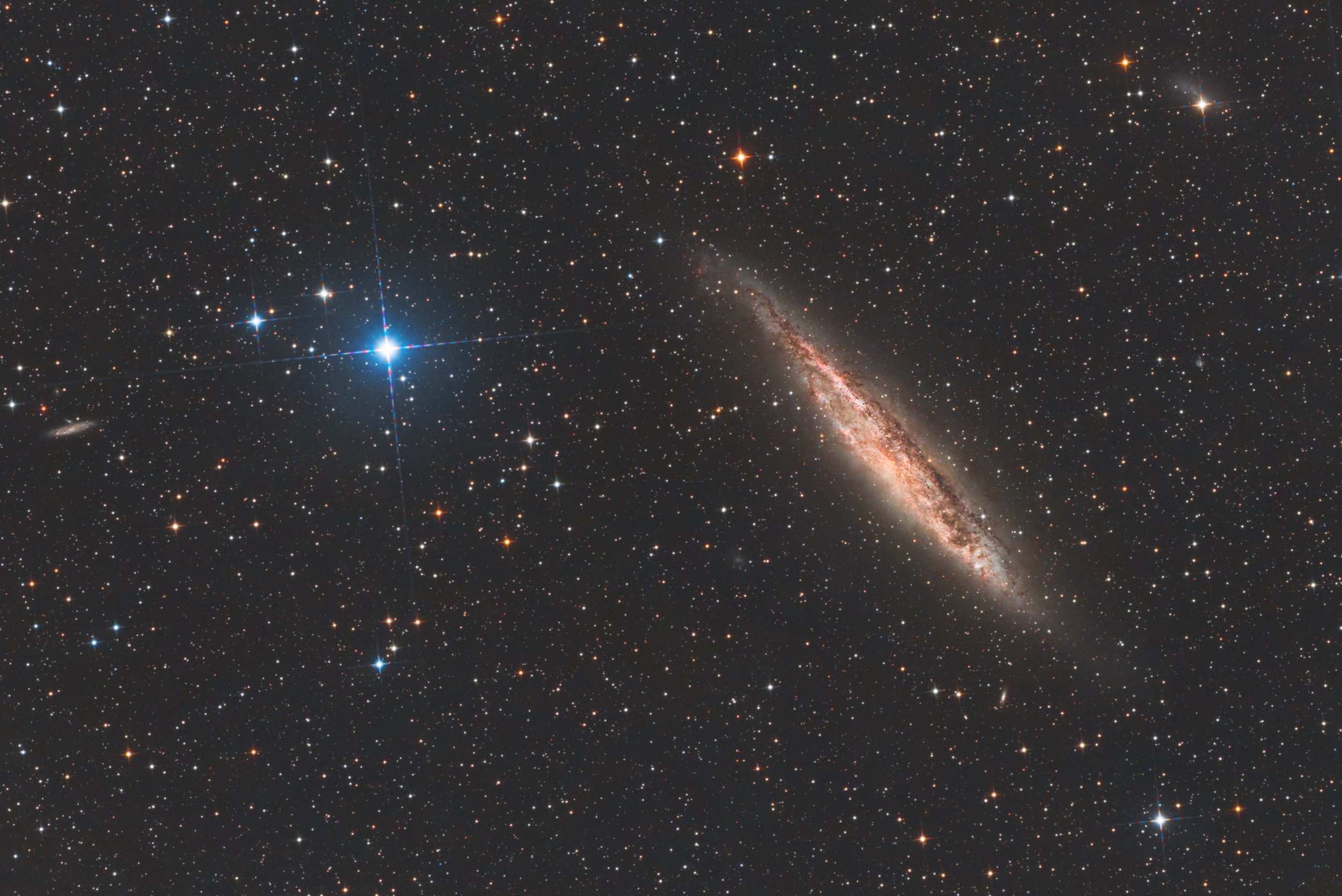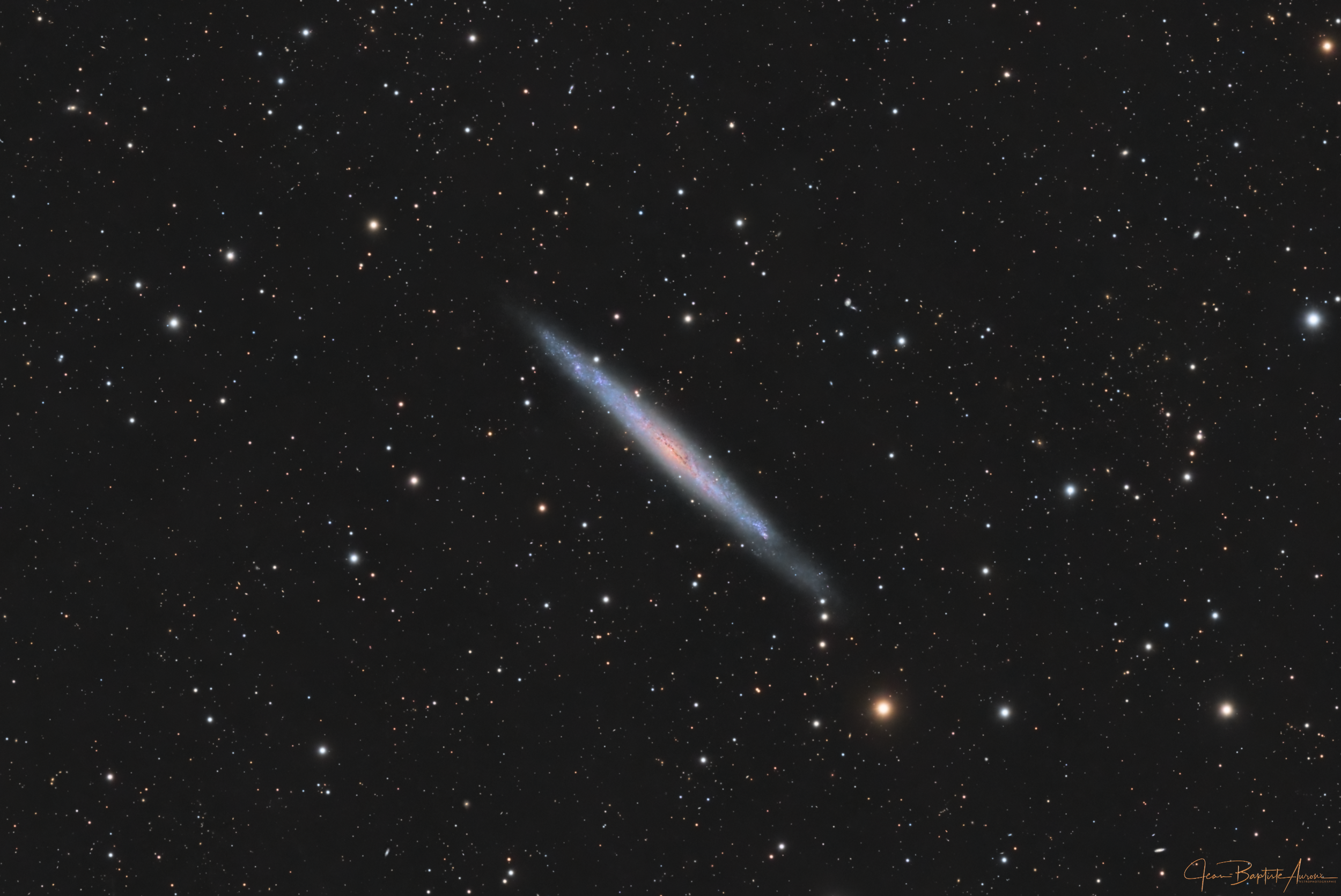
AAPOD2 Image Archives
A Blade in the Sky (12P/Pons-Brooks)
Comet 12P/Pons-Brooks, discovered by Jean-Louis Pons and William Robert Brooks, is currently putting on a spectacular show in the night sky. This comet, with its characteristic bright coma and long, luminous tail, has earned the nickname "the Blade" due to its distinctive, sharp appearance against the backdrop of the cosmos. The tail of the comet, composed of dust and gas, stretches across the sky, reflecting sunlight and creating a mesmerizing display.
As 12P/Pons-Brooks traverses its highly elliptical orbit around the Sun, it offers a unique opportunity for both amateur and professional astronomers to study its composition and behavior. Comets like Pons-Brooks are considered ancient relics from the early solar system, providing valuable insights into the conditions and materials present during its formation. Observing this celestial spectacle not only brings beauty to the night sky but also contributes to our understanding of the solar system's history.
Milky Way and STEVE
STEVE, or Strong Thermal Emission Velocity Enhancement, is a fascinating atmospheric phenomenon distinct from typical auroras. Unlike the common green and red hues of auroras caused by charged particles from the solar wind interacting with Earth's magnetic field, STEVE appears as a purplish arc with "picket fence" structures of green light. This phenomenon has intrigued scientists and citizen scientists alike, leading to its formal identification and study in recent years.
STEVE occurs at lower latitudes compared to traditional auroras and is associated with high-speed streams in the upper atmosphere. The exact mechanisms behind STEVE are still under investigation, but it is believed to involve different physical processes, possibly related to ionospheric heating and particle precipitation. Observations of STEVE, often captured by amateur photographers and skywatchers, provide valuable data that help scientists better understand the complex interactions between solar activity and Earth's magnetosphere.
The Cat's Eye Galaxy
Messier 94 (NGC 4736) is a striking spiral galaxy located approximately 16 million light-years away in the constellation Canes Venatici. This galaxy is known for its bright, star-forming ring, which surrounds a prominent central region. The ring is an area of intense star formation, giving M94 its unique and vibrant appearance. The galaxy's tightly wound spiral arms and bright nucleus make it a popular target for both professional and amateur astronomers.
One of the interesting features of M94 is its classification as a double-ringed galaxy, with an inner ring of young, hot stars and an outer ring that is more diffuse. The galaxy's inner region is dominated by older stars and shows little evidence of star formation. The distinct rings are thought to be caused by waves of density propagating through the galaxy, compressing gas and triggering star formation as they go. This fascinating structure offers valuable insights into the dynamics of spiral galaxies and the processes that drive star formation.
SH2-91: The Other Veil
Sh2-91 is a faint and intricate supernova remnant located in the constellation Cygnus, also known as the Network Nebula. This remnant is part of a larger supernova event that occurred thousands of years ago, scattering stellar material across the region. It is characterized by its delicate filaments of gas and dust, glowing predominantly in hydrogen-alpha light, which creates a striking visual of interwoven tendrils against the backdrop of the Milky Way.
The distance to Sh2-91 is estimated to be around 2,600 light-years from Earth. This remnant is particularly interesting to astronomers due to its complex structure and the insights it provides into the aftermath of supernova explosions. The remnants of the progenitor star interact with the surrounding interstellar medium, offering clues about the life cycle of stars and the dynamics of supernova remnants. Sh2-91, with its ethereal appearance, is a testament to the powerful and violent processes that shape our galaxy.
Colliding Spirals - NGC 4038 & 4039 - The Antennae Galaxies
NGC 4038 and NGC 4039, collectively known as the Antennae Galaxies, are a pair of colliding spiral galaxies located about 60 million light-years away in the constellation Corvus. These galaxies are named for their long, antenna-like tidal tails of stars and gas, formed by the gravitational forces of their interaction. This cosmic collision has been ongoing for hundreds of millions of years, resulting in spectacular formations and triggering intense regions of star formation.
The Antennae Galaxies provide a vivid snapshot of galactic evolution and the processes that occur when galaxies merge. The collision has compressed vast clouds of gas and dust, leading to the birth of new stars and massive star clusters, some of which are among the brightest and most massive known. Observations in various wavelengths, from visible light to X-rays, reveal the complex structure and dynamic activity within these interacting galaxies, offering valuable insights into the life cycles of galaxies and the role of cosmic collisions in shaping the universe.
Complex Ro Ophiuchi
The Complex Ro Ophiuchi, one of the most striking and vivid regions in the Milky Way, dazzles with its intricate interplay of dust, gas, and starlight. This star-forming region, located about 460 light-years away in the constellation Ophiuchus, showcases a remarkable tapestry of colors and textures. The image reveals a rich canvas where deep, dark nebulae contrast sharply with bright, reflective regions illuminated by newborn stars. The vibrant blues and reds hint at the presence of hot, young stars and their energetic interactions with the surrounding interstellar medium. This dynamic environment is a hotbed of stellar activity, where the forces of gravity and radiation shape and mold the cosmic landscape into a mesmerizing celestial masterpiece.
In the heart of the Ro Ophiuchi complex lies the brilliant star Rho Ophiuchi, whose intense light scatters off the nearby dust, creating a striking reflection nebula. The dense clouds of dust and gas are not just picturesque but are also fertile grounds for star formation. Within these obscuring veils, protostars are born, eventually emerging as fully-fledged stars that will light up the galaxy. This region's proximity and activity make it an invaluable laboratory for studying the early stages of stellar evolution. Through this breathtaking image, we get a glimpse into the ongoing processes that have shaped our own solar system, revealing the timeless beauty and complexity of the universe.
M57: The Ring nebula
The Ring Nebula, also known as Messier 57 (M57), is a classic planetary nebula located in the constellation Lyra, about 2,300 light-years away from Earth. This nebula is the remnants of a star similar in mass to the Sun, which shed its outer layers as it reached the end of its life cycle. The expelled material forms the characteristic glowing ring, while the hot core of the star, now a white dwarf, illuminates the nebula from within.
M57 is a well-studied object due to its bright and distinctive appearance, making it a popular target for both amateur and professional astronomers. The nebula's ring structure is primarily composed of ionized hydrogen and helium, which emit light in vivid colors, typically seen in red and green hues through telescopes. Observations have revealed intricate details within the nebula, including knots and filaments of gas, which provide insights into the processes of stellar evolution and the dynamic interactions between the ejected material and the surrounding space.
ARP 159 and NGC 4725
ARP 159
ARP 159 is a striking pair of interacting galaxies located in the constellation of Lynx. This system features a peculiar, distorted structure resulting from the gravitational interactions between the galaxies. The larger galaxy exhibits a warped, elongated shape with prominent tidal tails, indicating a past collision or close encounter with its smaller companion. These interactions often trigger bursts of star formation, evident from the bright blue regions within ARP 159, where new stars are being born. This dynamic interplay provides astronomers with a valuable opportunity to study the effects of galactic mergers and the evolution of galaxies over cosmic timescales.
NGC 4725
NGC 4725 is a unique barred spiral galaxy situated in the constellation of Coma Berenices. Unlike typical spiral galaxies, NGC 4725 possesses a single, prominent spiral arm extending from a central bar structure. This distinctive feature makes it an object of interest in the study of galactic morphology and dynamics. The galaxy's core is bright and active, hosting regions of intense star formation. Additionally, NGC 4725 is known for its Seyfert 2 nucleus, indicating the presence of an active galactic nucleus powered by a supermassive black hole. This galaxy offers insights into the complex processes governing the formation and evolution of spiral structures and the role of central bars in galactic development.
M 33 - Triangulum Galaxy (HaOIII-RGB)
The Triangulum Galaxy (M33) is located approximately 3 million light-years away in the constellation Triangulum. This galaxy is teeming with beautiful and intricate structures that captivate both amateur and professional astronomers alike. Its grand spiral arms are adorned with stunning star clouds and intricate dust lanes, which add to its visual splendor and scientific interest.
Particularly noteworthy are the galaxy's numerous nebulae, rich in hydrogen-alpha (Ha) and doubly ionized oxygen (OIII) emissions. These nebulae, often glowing in both Ha and OIII light, highlight regions of intense star formation. Observing these features in the Triangulum Galaxy not only provides a dazzling display of cosmic beauty but also offers valuable insights into the processes of star birth and galactic evolution.
Leo Triplet with tidal tail
The Leo Triplet, also known as the M66 Group, is a stunning collection of three interacting spiral galaxies located about 35 million light-years away in the constellation Leo. This trio comprises the galaxies M65, M66, and NGC 3628. The gravitational interactions between these galaxies create fascinating tidal features, most notably the prominent tidal tail extending from NGC 3628. This tail is composed of stars and gas pulled out from the galaxy due to the gravitational forces exerted by its neighbors.
In this image, the delicate structure of the tidal tail is beautifully captured, highlighting the dynamic nature of galactic interactions. The Leo Triplet offers a unique opportunity to observe the effects of gravitational forces on galaxy morphology and evolution. Detailed imaging and study of these features help astronomers understand the processes that shape galaxies and the role of tidal interactions in galactic development. Observing the Leo Triplet with such clarity provides not only a visually striking display but also a wealth of scientific insights into the mechanics of our universe.
M94 in Canes Venatici
NGC 4736, commonly known as M94, is a stunning spiral galaxy located in the constellation Canes Venatici. This galaxy, situated about 16 million light-years from Earth, features a unique ring structure that sets it apart from other spiral galaxies. The bright inner ring is an area of intense star formation, a phenomenon driven by the galaxy's central bar structure which funnels gas towards the core. This ring of young, hot stars gives M94 its distinctive appearance and makes it a popular target for astronomers and astrophotographers alike.
Hades SNR
The Hades Supernova Remnant (SNR), an impressive testament to amateur astronomy, is the third largest SNR ever discovered by non-professionals. This massive structure, located in the constellation Auriga, spans an incredible region of the sky and serves as a profound reminder of the violent stellar events that shape our universe.
Characterized by intricate filaments and diffuse clouds of gas, the Hades SNR reveals the remnants of a colossal supernova explosion that occurred thousands of years ago. The faint yet expansive nature of this SNR made it a challenging target to detect, underscoring the dedication and skill of the amateur astronomers who brought it to light. Their discovery adds a significant piece to the puzzle of our galaxy's history, illustrating the critical contributions of amateur astronomers to the field of astrophysics.
M101 in LRGB
Messier 101 (M101), also known as the Pinwheel Galaxy, is a grand-design spiral galaxy located approximately 21 million light-years away in the constellation Ursa Major. With a diameter of about 170,000 light-years, it is nearly twice the size of the Milky Way. M101's well-defined spiral arms are rich in star-forming regions, evidenced by the numerous HII regions that dot its structure. These regions are massive clouds of hydrogen gas that glow brightly due to the ionizing radiation from young, hot stars within them.
An interesting aspect of M101 is its asymmetrical shape, which is likely the result of gravitational interactions with its neighboring galaxies. This interaction has caused a distortion in its spiral arms, making them appear uneven. Additionally, M101 has a high surface brightness, making it a favorite target for amateur astronomers. Despite its beauty and prominence, M101's distance from Earth means that observing its finer details requires a telescope with good resolution and light-gathering capabilities.
IC 417, IC 410 & IC 405. Three-panel mosaic in HaLRGB
This three-panel mosaic showcases the intriguing nebulae IC 417, IC 410, and IC 405, captured in HaLRGB. These emission nebulae are located in the constellation Auriga and present a stunning array of colors and structures.
IC 417, often referred to as the Spider Nebula, lies approximately 10,000 light-years from Earth. It features a cluster of young stars known as Stock 8, whose intense radiation ionizes the surrounding gas, creating the nebula's characteristic glow.
IC 410, also known as the Tadpoles Nebula, is located about 12,000 light-years away. It contains the open star cluster NGC 1893, which energizes the nebula. Notably, IC 410 includes two striking "tadpole" structures, which are dense regions of gas and dust being sculpted by stellar winds and radiation.
IC 405, the Flaming Star Nebula, is roughly 1,500 light-years from Earth. It is illuminated by the variable star AE Aurigae, which is believed to have been ejected from the Orion Nebula region millions of years ago. The interaction of AE Aurigae's intense light with the surrounding hydrogen gas creates a spectacular emission and reflection nebula, exhibiting striking red and blue hues.
Together, these nebulae form a vibrant tapestry of star formation and cosmic activity, offering a vivid glimpse into the dynamic processes shaping our galaxy.
Loop prominences
On May 13, 2024, an extraordinary solar event was captured, featuring active region AR3664. This sunspot region was responsible for a massive solar storm that generated auroras visible as far south as South Florida. Such displays are exceptionally rare at these latitudes, making the event a significant occurrence for both professional and amateur astronomers.
The image also showcases a beautiful loop prominence, a spectacular feature that was visible using an H-alpha filter. Loop prominences are large, glowing loops of plasma that extend from the Sun's surface, following magnetic field lines. These prominences provide a stunning visual representation of the Sun's magnetic activity and are key to understanding solar dynamics and space weather phenomena.
Comet C/2021 S3 (Panstarrs) in Cygnus
Comet C/2021 S3 (PANSTARRS) is a long-period comet that was discovered by the Pan-STARRS survey on September 27, 2021. The comet's highly elliptical orbit takes it from the distant reaches of the solar system into the inner solar system, where it becomes visible from Earth. As it approaches the Sun, the comet's icy nucleus heats up, causing it to shed gas and dust and form a glowing coma and often a tail that points away from the Sun.
One of the notable features of C/2021 S3 (PANSTARRS) is its brightness, which has allowed for detailed observations and photography by both professional and amateur astronomers. The comet's composition provides insights into the early solar system, as it is made up of primordial materials that have remained largely unchanged since the solar system's formation. Observations of the comet's behavior and its interactions with solar radiation help scientists understand the physical and chemical processes that occur in these distant celestial visitors.
NGC 4945-Barred Spiral Galaxy in Centaurus
NGC 4945 is a striking barred spiral galaxy located approximately 13 million light-years away in the constellation Centaurus. It is one of the brightest galaxies in the Centaurus group and is notable for its prominent bar structure and extensive, well-defined spiral arms. The galaxy's edge-on orientation provides a spectacular view of its elongated shape and central bulge.
NGC 4945 is also of significant interest to astronomers because of its active galactic nucleus (AGN), which harbors a supermassive black hole. This black hole is a source of intense X-ray emissions, making NGC 4945 one of the brightest X-ray galaxies in the sky. The presence of the AGN suggests high levels of activity and energetic processes occurring in the galaxy's core, offering valuable opportunities for studying the dynamics of black holes and their influence on their host galaxies.
NGC 4214 - irregular galaxy in Canis Venatici
NGC 4214 is an irregular galaxy located in the constellation Canes Venatici, approximately 10 million light-years from Earth. This galaxy is characterized by its chaotic structure, lacking the defined spiral arms or elliptical shape seen in more regular galaxies. NGC 4214 is a prolific star-forming region, with numerous bright star clusters and massive young stars scattered throughout its irregular form.
One of the notable features of NGC 4214 is its large H II regions, where intense star formation is occurring. These regions are illuminated by the ultraviolet light from young, hot stars, causing the surrounding hydrogen gas to glow brightly. Observations have revealed that NGC 4214 contains both young and old stellar populations, making it an excellent laboratory for studying the processes of star formation and galactic evolution. The galaxy's irregular shape and active star-forming regions provide valuable insights into the dynamics and history of irregular galaxies.




















